A previous blog entry, Healthy Soils for Healthy Trees, discussed the importance of preserving soil structure from being destroyed by compaction. Together, soil texture and soil structure have the greatest influence on pore space in soil, and how easily air, water, and roots can move through a soil.
Many people are aware of what soil texture – proportions of sand, silt and clay – they are dealing with on a site; however, few people consider a soil’s structure, even though in most soils, the structure is just as important as the texture. Two soils with the same texture can behave very differently depending on their structure. A clay soil, for example, can be easy for air, water, and roots to move through with good structure, or be almost impenetrable by roots, air, and water when its structure has been destroyed by compaction.
How soil structure develops
Soil structure refers to how particles of soil are grouped together into aggregates (also called peds). They are cemented or bound together by physical, chemical, and biological processes.
Physical-chemical processes that build soil structure include:
- Polyvalent cations like Ca2+, magnesium Mg2+, and aluminum Al3+ bind together clay particles.
- Soil particles are pushed closer together by freezing and thawing, wetting and drying, and by roots pushing through the soil as they grow in length and width.
Biological processes that build soil structure include:
- Soil particles are cemented together by humus, by organic glues created by fungi and bacteria decomposing organic matter, and by polymers and sugars excreted from roots.
- Fungal hyphae and fine roots stabilize aggregates (University of Minnesota Extension 2002).
Organic matter and plant roots are therefore key to soil structure.
How soil structure deteriorates
Factors that can deteriorate or destroy soil structure include:
- Compaction
- Cultivation
- Removal of vegetation
- Excessive moving and handling of soil
- Screening
- Excessive sodium
A high proportion of sodium to calcium and magnesium causes clay particles to repel each other when wet, so aggregates are dispersed, and the process of soil structure formation is reversed. Soils with too much sodium become almost impermeable to water because the dispersed clay and small organic particles clog up remaining soil pores (Donahue et al 1983). Excessively high sodium levels can result from irrigation and salting roads.
Different types of soil structure
Soil structure is classified by type (shape), class (size) of peds, and grade (strength of cohesion) of aggregates. The shape, size, and strength of aggregates determine pore structure, and how easily air, water, and roots move through soil (Donahue et al 1983).
Figure 1 shows the different types of soil aggregates, and how easily water typically moves through each of these types.
Granular structure is the most common in surface soil layers, especially those with adequate organic matter. Granular structures offer the most pore space of any structure (Cooperative Soil Survey, no publication date given).
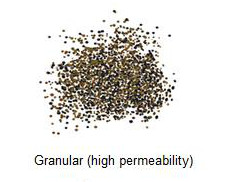
Image from Victorian Resources
Columnar structure is often found in soils with excessive sodium, due to the dispersing effects of sodium, which destroys soil structure, rendering the soil effectively sealed to air and water movement (Cooperative Soil Survey, no publication date given).
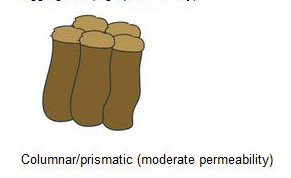
Image from Victorian Resources
Platey structure has the least amount of pore space and is common in compacted soils (Cooperative Soil Survey, no publication date given).
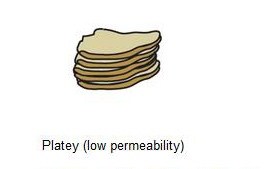
Image from Victorian Resources
Some soils have no true structure, like single grain soils (like a loose sand with little to no attraction between the grains of sand), and massive soils (large cohesive masses of clay).
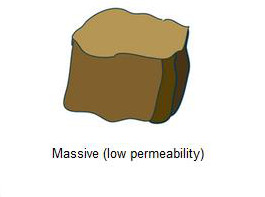
Image from Victorian Resources
For more information on soil structural classification, see the resources listed in the references section below.
Ways to preserve desirable soil structure
As the USDA Natural Resources Conservation Service (2008) explains: “practices that provide soil cover, protect or result in the accumulation of organic matter, maintain healthy plants, and avoid compaction improve soil structure and increase macropores.”
Other key practices to preserve soil structure include eliminating soil screening and minimizing handling, and avoiding the use of sodium salts.
Dr. Clay Robinson, a soil specialist, also lists these factors as influential in the formation of soils (and their renewability over time): climate, organisms, relief, parent material, and time. For a more in-depth analysis of the soil renewability, please check out our blog.
Implications for bioretention
Preserving soil structure may increase the range of soil textures acceptable for bioretention. Bioretention soils are often sand-based, primarily to ensure adequate infiltration rates. Clay and silt content is often limited to a maximum of only 3 to 5 percent, which is very, very low, limiting soils to sands according to the soil textural triangle. While a clay soil that has been screened and has no structure will have a very low infiltration rate, with proper structure, many soils with more clay can also have adequate infiltration rates. Increasing clay content above the very low maximum of 3 to 5 percent could provide important benefits, including increased soil water holding capacity and increased cation exchange capacity, which increase potential pollutant removal. When increasing clay content, however, keep in mind that the higher the clay content, the more crucial it becomes to protect soil from compaction and from excess salt, as clay soils are more prone to compaction and loss of structure, and unacceptable decrease of infiltration rates due to dispersion from sodium ions.
References
Cooperative Soil Survey. No publication date given. Soil Structure – Physical Properties.
Donahue, Roy L., Raymond W. Miller, and John C. Shikluna. 1983. Soils: and introduction to soils and plant growth. Fifth Edition. Prentice-Hall, Inc.: Englewood Cliffs, N.J.
Plaster, Edward J. 1992. Soil Science and Management. Second Edition. Delmar Publishers, Inc.: Albany NY.
University of Minnesota Extension. 2002. The Soil Scientist.
USDA Natural Resources Conservation Service. 2008. Soil Quality Indicators.
Nathalie Shanstrom is a landscape architect with The Kestrel Design Group.

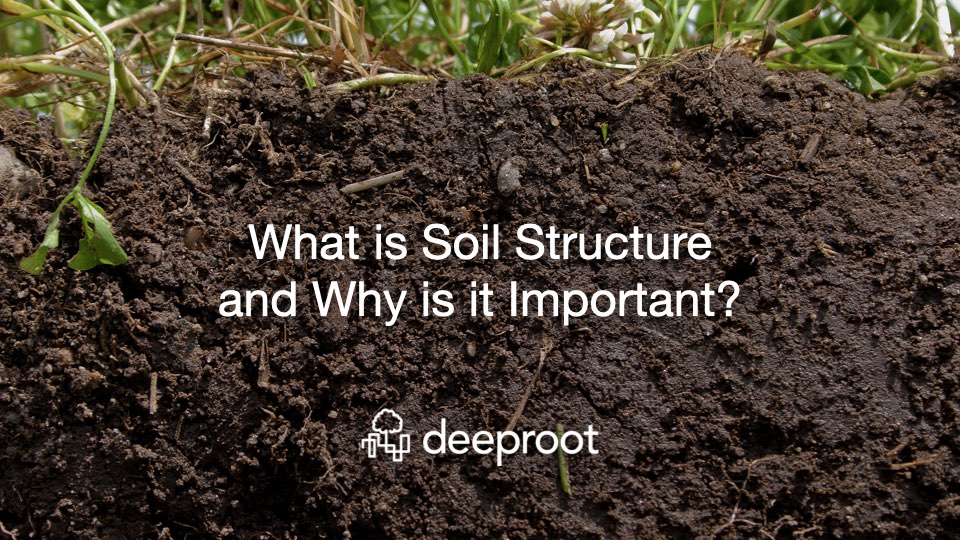
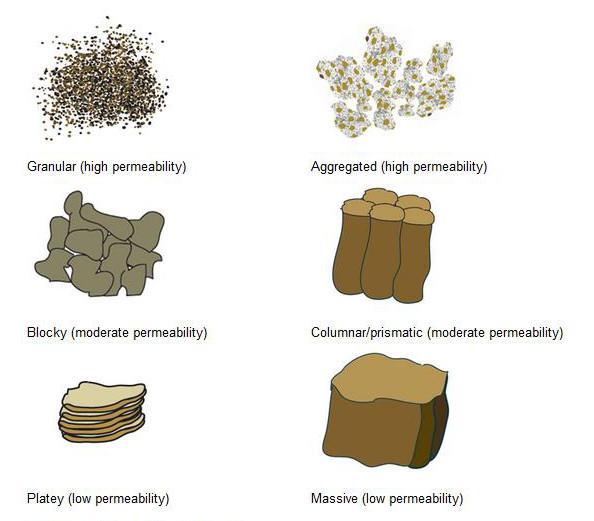




What a great article! I have been advising landscape architects, engineers and contractors on the importance of soil structure for many years and this article summarizes it very well.
Thanks, Tim! Coming from you we take that as high praise. Nathalie did a really great job on this one.
Thanks for this overview. I am very interested in how soils develop structure over time. I am excited by the research on glomalin and other structural organics. I wonder if the time will come that soils are “farmed” just as plants are. For example, I could see an operation where the soil components are trucked into a production site, mixed to specification, and spread. Plants that foster glomalin production are then seeded on the soil substrate and innoculated with the glomalin-producing mycorhyzae. The whole thing is allowed to grow undisturbed for several years, and then harvested for use in Silva Cells or other urban applcations, using the handling care that Jim Urban prescribes. We have some folks around here that are making “designer” soils, but I don’t know of anyone who is specifically “growing” soil for good structure. From what I can tell, Jim Urban relies on “found” soil to get good structure. This is understandable, but does not seem sustainable. I would enjoy reading your response.
Thanks for your comment! Farmed soils are a very intriguing and exciting idea! I am interested in learning more about glomalin and soil structure too. Fascinating to think how long people didn’t know much about it and it leads me to wonder how much more we may not know about soil structure yet! As far as using “found soil” or “farmed soil”, perhaps it would depend on project conditions which might be more sustainable – assuming soils would be “grown” for structure at some point in the future? Another option, in areas where there is not a lot of time pressure, perhaps soils could be “farmed” in place. We do often add mycorrhizae to our restoration projects on poor soils with the intent of creating a healthy soils and plants over time. Thank you again for sharing your comment!